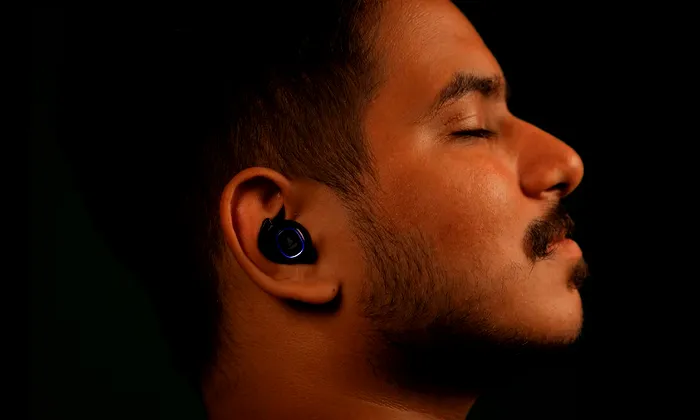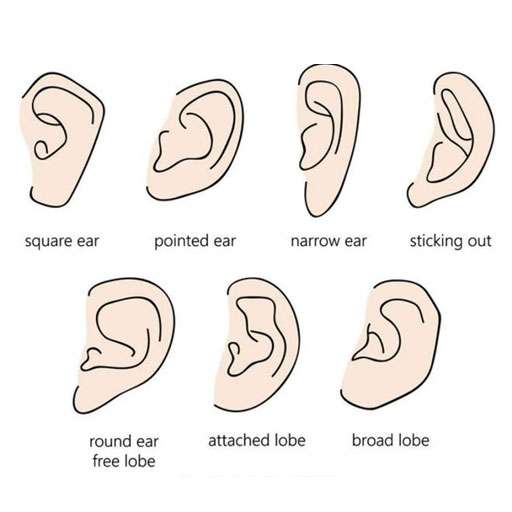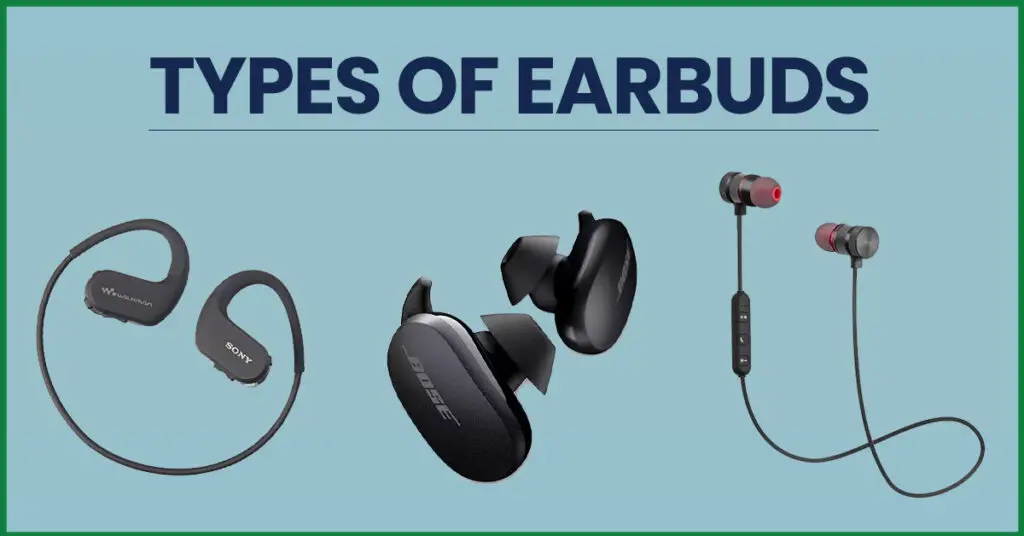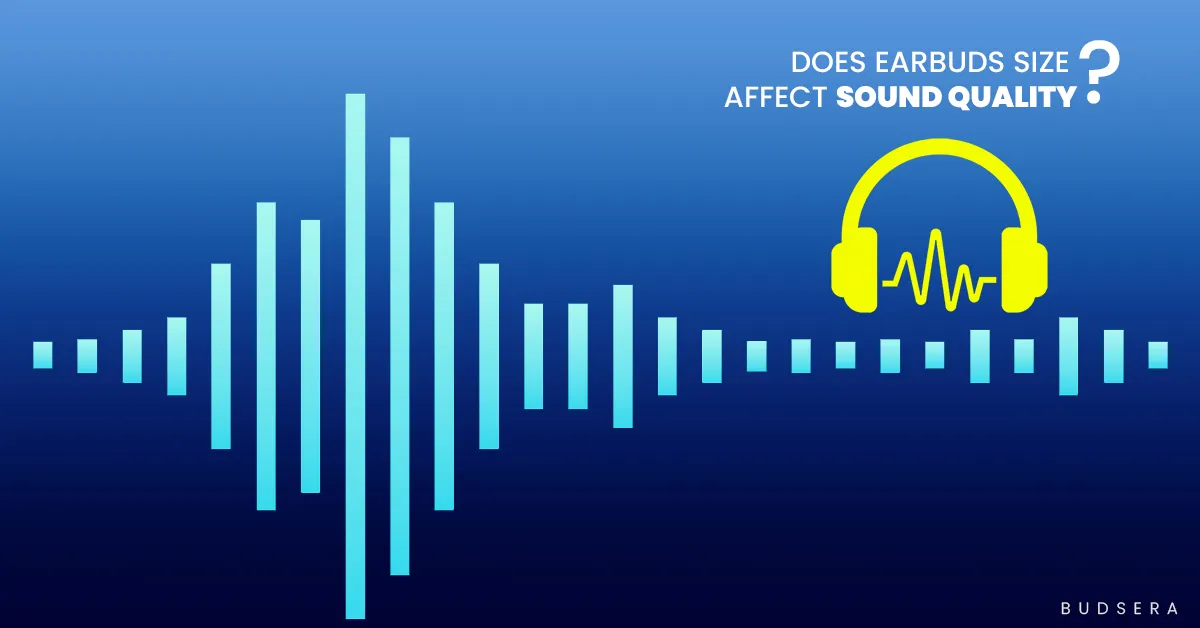Do you like using earbuds to listen to music or podcasts while you’re on the go? Have you ever considered whether the size of your earbuds influences the sound? If so, you are not alone. How earbud size affects the listening experience is a topic of much interest. The size of your earbuds can, in fact, impact the sound quality you hear.
One size does not fit all when it comes to earbuds. To accommodate diverse ear canal shapes and sizes, earbuds come in various sizes and forms. The earbud’s size directly influences how well it fits in your ear, which in turn affects how much outside noise is muffled, how much bass is created, and other factors.
So, it’s essential to know how earbud sizes can impact your listening experience and choose the right earbuds accordingly.
In this article, we’ll discuss the different sizes of earbuds available in the market, how to determine the right size for your ears, and how to ensure that you’re getting the best sound quality out of your earbuds. We’ll also examine the importance of a good seal and how it can affect sound quality.
How Your In-Ears Fit Matters A Lot
Now that we’ve established that the size of your earbuds can impact sound quality, it’s important to delve deeper into how the fit of your in-ears can make a significant difference.
When earbuds fit well into your ear canal, they create a seal that blocks out external noise and keeps the sound inside your ears. This is crucial for experiencing optimal sound quality, especially in noisy environments.
According to the World Health Organization (WHO), poorly fitting earbuds can lead to increased sound pressure levels in the ear canal, which may cause hearing damage over time. This highlights the importance of selecting the right size and fit of earbuds to ensure optimal sound quality without compromising hearing health.
In addition to blocking out external noise, a good fit also ensures that the earbuds don’t move around in your ear canal. When earbuds move, it affects the sound quality as the positioning of the speakers changes. This can lead to distortion, loss of bass, and an overall reduction in sound quality.
Finding the right fit for your earbuds can also help prevent long-term hearing damage. Earbuds that don’t fit properly can cause sound leakage, which means that you’ll need to increase the volume to hear the music clearly.
Listening to loud music for extended periods can lead to noise-induced hearing loss, a condition that affects millions of people worldwide.
What Actually is Earbud Size?
Earbud size refers to the physical dimensions of the earbuds, including the size and shape of the earpiece, the length of the cable, and the size of any additional components such as the microphone or control buttons.
Earbuds come in different sizes and shapes to fit a variety of ear sizes and shapes, and finding the right size is essential for optimal sound quality and comfort.

How Does Earbuds Size Affect Sound Quality?
| Aspect | Larger Earbuds | Smaller Earbuds |
|---|---|---|
| Bass Response | Deeper, richer bass | Weaker bass |
| Treble Clarity | Clearer treble | May get distortion |
| Mid-Range | More balanced mid-range | Weaker mid-range |
| Audio Isolation | Depends on the Fit | Depends on the Fit |
| Comfort Level | May not fit well, uncomfortable | Comfortable fit |
| Soundstage | Wider soundstage | Narrower soundstage |
| Sound Leakage | More sound leakage | Less sound leakage |
| Durability | Sturdier and more durable | More fragile and prone to damage |
The earbud size can affect several aspects of sound quality. Let’s take a closer look at the different ways in which earbud size can impact your listening experience.
Bass Response
In comparison to smaller earphones, larger earbuds typically produce a deeper, richer bass sound. Because larger earbuds offer more space for the bass driver, a larger diaphragm and more air movement are possible.
Smaller earbuds, on the other hand, frequently have lower bass since there is less room for the driver and less air movement. Particularly for bass-heavy genres like hip-hop or electronic music, this might lead to a less immersive and pleasurable listening experience.
Audio Isolation
A good fit is essential for noise isolation since it can lower outside noise and enhance the sound in general. Better noise isolation and the exclusion of undesirable sounds that can interfere with your listening experience can be achieved with earbuds that comfortably fit into the ear canal.
Treble Clarity
Smaller earbuds may struggle to accurately reproduce higher frequencies and complex layers with a lot of trebles. This can lead to muffled or distorted sounds that lack the necessary detail and clarity.
On the other hand, larger earbuds provide more space for these frequencies to be reproduced, resulting in a clearer treble response.
Mid-Range
The mid-range is another important aspect of sound quality affected by the size of your earbuds. This range encompasses the frequencies between the bass and treble, such as vocals and guitar riffs.
Smaller earbuds may struggle to accurately reproduce mid-range frequencies, resulting in a loss of detail and a lack of fullness in the sound. On the other hand, larger earbuds with bigger drivers can provide a more accurate and full-bodied mid-range response.
Comfort Level
Comfort level is a crucial consideration when choosing an earphone size. Too-small or too-large earbuds may hurt your ears, fall out, or otherwise be uncomfortable. This may seriously interfere with your ability to listen and cause severe distraction.
Some people may find that smaller earbuds are more pleasant since they are more discretely inserted into the ear canal. Others, however, may find larger earbuds to be more pleasant as they offer a more secure fit and evenly distribute pressure.
Soundstage
It is true that your experience of depth and space when listening to audio can be influenced by the size and type of earbuds you wear. Smaller earbuds may generate a more condensed and two-dimensional soundscape, whilst larger earbuds may produce a more immersive and three-dimensional soundstage.
This is because larger earbuds have more room for several drivers and a larger sound chamber, allowing for wider frequency response and better sound separation. On the other hand, smaller earbuds might have a constrained frequency response and less space between sounds, which would make listening less immersive.
Sound Leakage
Earbud size can also impact sound leakage or the amount of audio that escapes and can be heard by others. Smaller earbuds generally have a tighter fit that reduces sound leakage, while larger earbuds may have a looser fit and result in more leakage.
Durability
The durability of earbuds can also be impacted by their size. Smaller earbuds may have less structural support and be more prone to damage, while larger earbuds may be more robust but also heavier and more cumbersome.

Other Earbuds Components that Can Affect Sound Quality
While the size of earbuds is a major factor that can affect sound quality, it’s not the only component to consider. Other elements such as drivers, materials, and wiring can also play a significant role in determining the quality of sound you experience.
- Types of Earbuds
- Material Of The Earbuds
- Driver Type
- Sensitivity Of The Earbuds
- Impedance
Types of Earbuds
The kind of earphones you select can also have an impact on the sound quality you hear. Earbuds come in two major varieties: in-ear and on-ear.
In-ear earbuds are made to fit inside the ear canal, forming a seal that helps to muffle outside noise. This may lead to a richer, more realistic audio experience.
Conversely, on-ear earbuds lie on the exterior of the ear and don’t seal. While this may result in a more comfortable fit, it might also cause a loss of clarity and fine detail in the sound.
Selecting the earbud that best suits your listening habits can be made easier if you are aware of the differences between these two varieties.
Material Of The Earbuds
When it comes to the material of earbuds, it’s not just about comfort and fit but also the impact on sound quality. The type of material used can significantly affect sound isolation and overall sound quality.
Foam, rubber, or silicone ear tips are commonly used in earbuds due to their ability to create a better seal in the ear canal, which reduces background noise and enhances sound quality. On the other hand, hard plastic ear tips can produce a weaker seal and may lead to sound leakage.
Additionally, the shape of the ear tips also plays a vital role in sound quality. Double-flanged tips are known to provide a better seal than single-flange tips, resulting in improved noise isolation and overall sound quality.
“Please hold on! We will discuss Eartips in detail later in this post.”
Driver Type
The type of driver used in earbuds can have a significant impact on sound quality. Drivers consist of a diaphragm and a voice coil, with the diaphragm producing sound and the voice coil converting electrical signals into sound waves.
- Dynamic drivers
- Balanced armature drivers
- Hybrid
Dynamic drivers, which have been around for decades, are the most common type used in earbuds. They feature a cone-shaped diaphragm and voice coil and typically deliver good bass responses.
Balanced armature drivers, on the other hand, are smaller than dynamic drivers and feature two small arms that vibrate when an electrical signal is sent through them. They provide excellent detail, fidelity, and accuracy at higher frequencies.
Hybrid earbuds combine both dynamic and balanced armature drivers for optimal performance. This driver technology allows for a great bass response while maintaining high-fidelity audio reproduction at high frequencies. IEMs (in-ear monitors) typically use hybrid driver technology to deliver the best possible performance.
Sensitivity Of The Earbuds
The sensitivity of earbuds refers to how efficiently they convert electrical signals into sound waves. A more sensitive earbud will require less power to achieve the same volume level as a less sensitive earbud.
Earbuds with high sensitivity ratings can produce louder sound without distortion at lower power levels, making them ideal for use with mobile devices like smartphones and tablets.
However, earbuds with high sensitivity ratings may also pick up more background noise, which can affect sound quality.
Impedance
The resistance of the electrical signal that passes through the earbuds is referred to as impedance. It can impact the sound’s volume and clarity and is measured in ohms.
Low-impedance earbuds, such as those that range in resistance from 16 to 32 ohms, can be powered by electronic devices like smartphones and tablets. They have high volume levels but might not be as accurate and detailed as earphones with higher impedance.
However, earbuds with a high impedance, such as those between 32 and 300 ohms, need more power to function and are usually utilized with expensive audio gear like amplifiers. Although they provide precise and detailed sound, they can need an extra amplifier to produce the appropriate volume.

Why do you need a good Seal?
Having a good seal is crucial for achieving optimal sound quality with earbuds. A proper seal blocks out external noise and prevents sound from leaking out of the earbuds. This means you can listen to your music at a lower volume and still hear all the details, which can protect your hearing.
A good seal also improves bass response, as it allows the earbud to create a better seal in the ear canal, resulting in improved low-frequency performance. Additionally, a good seal ensures that the sound is directed towards the eardrum, which improves overall sound quality and clarity.
Tips to Choose the Right Earbuds Size for Sound Quality?
Choosing the right size of earbuds can be crucial for achieving optimal sound quality. Here are some tips on how to choose the right size:
- Consider Your Ear Shape
- Look for Quality Materials
- Consider Your Listening Environment
- Test Different Earbuds Types

Consider Your Ear Shape
When choosing the right earbud size for sound quality, it’s important to consider the shape of your ears. Everyone’s ears are different, and certain earbud sizes and shapes may fit better than others. Some people may have smaller ear canals, while others may have larger ones.
Usually, earbuds come with multiple sizes of ear tips to help you find the right fit. A proper fit not only enhances comfort but also improves sound quality by providing a better seal and reducing sound leakage.
Which ear tips are the best?
The best ear tips for your earbuds depend on your personal preference and ear shape. Foam tips provide good sound isolation and comfort, while silicone tips offer durability and a better fit for those with smaller ear canals.
Double-flanged tips are ideal for reducing background noise, and triple-flanged tips provide the most secure fit for active use. It’s best to try out different types of ear tips to find the ones that provide the best sound quality and comfort for your ears.
How do silicone tips affect sound quality?
Silicone ear tips are known for providing a good seal in the ear canal, which helps block out external noise and increase bass response.
This is because the silicone material is soft and pliable, allowing it to conform to the shape of the ear canal and create a tight fit.
How do double-flange ear tips affect sound quality?
Double-flange ear tips can improve sound quality by creating a better seal in the ear canal, reducing background noise, and increasing bass response.
The second flange creates an additional seal further inside the ear canal, preventing sound from leaking out and blocking external noise from coming in.
This leads to a more immersive listening experience with better sound isolation and improved clarity. However, the fit may not be comfortable for everyone and may take some time to get used to.
Look for Quality Materials
It’s crucial to take the quality of the materials into account while selecting earbuds. The use of better materials can significantly affect comfort, durability, and sound quality.
Look for earbuds with strong connectors and high-quality wires that are resistant to tangling. Additionally, compared to cheaper plastic ear tips, earbuds with ear tips made of foam or silicone can offer better sound isolation and improved comfort.
Consider Your Listening Environment
The listening environment can also play a role in choosing the right earbuds. If you’re going to be using them in noisy environments, you may want to consider earbuds with better noise isolation or noise-canceling technology.
This will help block out external noise and allow you to focus on the music. On the other hand, if you plan on using your earbuds during physical activities like jogging or working out, you may want to opt for earbuds that provide a secure fit and won’t fall out easily.
It’s important to consider your listening environment and choose earbuds that are suitable for your needs.

Test Different Earbuds Types
Trying out different types of earbuds can help you find the right fit and sound quality for your needs. In-ear, on-ear, and bone-conduction earbuds are the most common types available. In-ear earbuds offer the best noise isolation and sound quality, while on-ear earbuds are more comfortable for longer listening sessions.
Bone conduction earbuds use vibrations to send sound through your cheekbones, making them a good choice for outdoor activities where you need to be aware of your surroundings. By testing out different types of earbuds, you can find the one that best fits your lifestyle and listening preferences.
What size earbuds suitable for small ears?
For small ears, it is recommended to use earbuds with smaller-sized ear tips. Some earbud models come with multiple ear tip sizes included in the package, so you can find the perfect fit for your ear canal.
Additionally, in-ear monitors (IEMs) tend to provide a better fit for smaller ears due to their customizable ear tips and snug fit. It’s important to measure the diameter of your ear canal and try on different sizes and types of earbuds to find the most comfortable and secure fit for your small ears.
What is the best type of earbud for sound quality?
There is no single best type of earbud for sound quality, as it largely depends on personal preference and usage. However, balanced armature drivers are often favored for their ability to provide excellent detail and accuracy at higher frequencies, while dynamic drivers are known for their good bass response.
Hybrid earbuds, which combine both types of drivers, can provide a balance of bass response and high-fidelity audio reproduction at high frequencies. Ultimately, it’s important to consider various factors such as ear tip material, listening environment, and personal fit when selecting earbuds for optimal sound quality.
Conclusion
Choosing the right earbuds can significantly enhance your music-listening experience. Paying attention to factors such as the type of driver, sensitivity, impedance, and seal can make a noticeable difference in sound quality.
Additionally, taking into consideration your ear shape, listening environment, and personal preferences can help you find the perfect pair of earbuds. With so many options available on the market, it’s important to take the time to research and test out different types to find the best fit for your needs.
- Charging Bluetooth Headphones During Use: Is It Possible? - January 9, 2024
- Why Over-Ear Headphones Best for Hearing Health? (7 Reasons) - December 12, 2023
- Fixing the Bose Earbuds Not Charging in Case Problem: Solutions That Work - November 24, 2023
